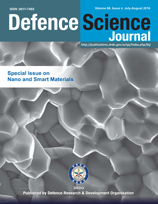A Novel Method for the Synthesis of Core-shell Magnetic Nanoparticle
DOI:
https://doi.org/10.14429/dsj.66.10203Keywords:
Magnetic nanoparticles, core-shell, drug-delivery, hyperthermia, nano-templatesAbstract
Core-shell type magnetic nanoparticles are finding attractive applications in biomedicine, from diagnostic to cancer therapy. Both for targeted drug delivery and hyperthermia, as well as a contrast agent used for external biomedical imaging systems, small (< 20 nm) superparamagnetic nanoparticles are desired. Some iron oxide nanoparticle formulations are already approved for human administration as contrast agent for magnetic resonance imaging. However, search continues for nanoparticles with higher saturation magnetisation. Metallic, bi-metallic and intermetallic magnetic nanoparticles are finding attention. Biocompatibility and optimal clearance are important criteria for the medical applications and therefore core-shell type particles are favored, where a biocompatible shell (e.g. polymer, Silica) can prevent inadvertent host reaction with the magnetic core. A recently developed novel synthesis method (electrochemical selective phase dissolution - ESPD), which can produce core-shell magnetic nanoparticles, is reviewed in this paper. ESPD, as the name suggests, uses electro-chemical separation of a phase from metallic alloys to synthesize nanoparticles. It is a versatile method and can be adopted to produce a wide range of nanostructures in addition to the core-shell magnetic nanoparticles.
Downloads
Published
How to Cite
Issue
Section
License
 Where otherwise noted, the Articles on this site are licensed under Creative Commons License: CC Attribution-Noncommercial-No Derivative Works 2.5 India
Where otherwise noted, the Articles on this site are licensed under Creative Commons License: CC Attribution-Noncommercial-No Derivative Works 2.5 India


